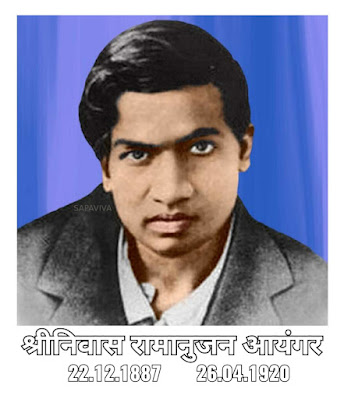𝐇𝐚𝐩𝐩𝐲 𝟏𝟑𝟔𝐭𝐡 𝐁𝐢𝐫𝐭𝐡𝐝𝐚𝐲 𝐭𝐨 𝐌𝐚𝐭𝐡𝐞𝐦𝐚𝐭𝐢𝐜𝐬 𝐆𝐞𝐧𝐢𝐮𝐬 𝐒𝐫𝐢𝐧𝐢𝐯𝐚𝐬𝐚 𝐑𝐚𝐦𝐚𝐧𝐮𝐣𝐚𝐧

𝐇𝐚𝐩𝐩𝐲 𝟏𝟑𝟔𝐭𝐡 𝐁𝐢𝐫𝐭𝐡𝐝𝐚𝐲 𝐭𝐨 𝐌𝐚𝐭𝐡𝐞𝐦𝐚𝐭𝐢𝐜𝐬 𝐆𝐞𝐧𝐢𝐮𝐬 𝐒𝐫𝐢𝐧𝐢𝐯𝐚𝐬𝐚 𝐑𝐚𝐦𝐚𝐧𝐮𝐣𝐚𝐧 𝗖𝗲𝗹𝗲𝗯𝗿𝗮𝘁𝗶𝗻𝗴 𝗡𝗮𝘁𝗶𝗼𝗻𝗮𝗹 𝗠𝗮𝘁𝗵𝗲𝗺𝗮𝘁𝗶𝗰𝘀 𝗗𝗮𝘆 𝟮𝟬𝟮𝟯 Dear fellow educators, Srinivasa Ramanujan (22 December 1887 – 26 April 1920) was an Indian mathematician, who made extraordinary contributions to mathematical analysis, number theory, infinite series, and continued fractions. Ramanujan independently compiled nearly 3900 results (mostly identities and equations). His work continues to inspire mathematicians even today! Srinivasa Ramanujan, born into a poor Brahmin family at Erode on Dec. 22, 1887, attended school in nearby Kumbakonam. By the time he was 13, he could solve unaided every problem in Loney's Trigonometry, and at 14 he obtained the theorems for the sine and the cosine that had been anticipated by L. Euler. Ra...




